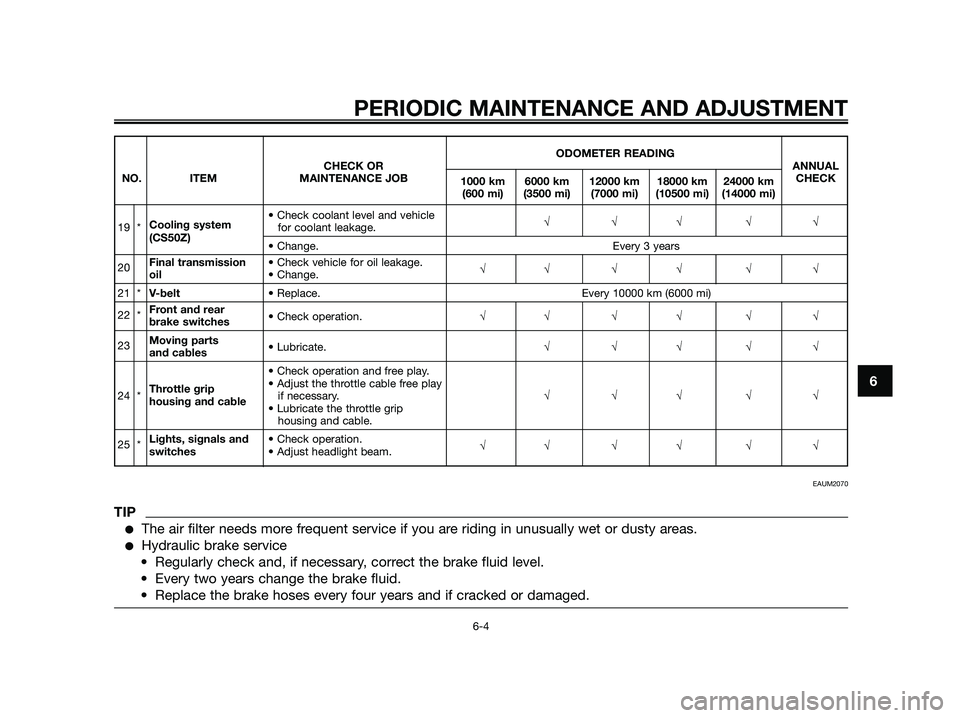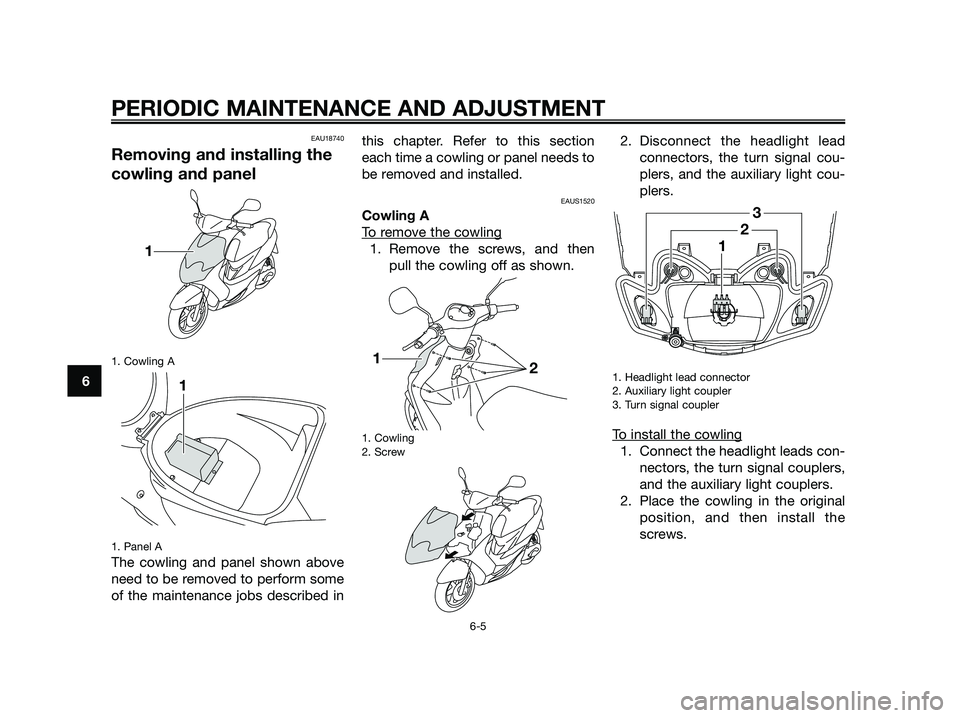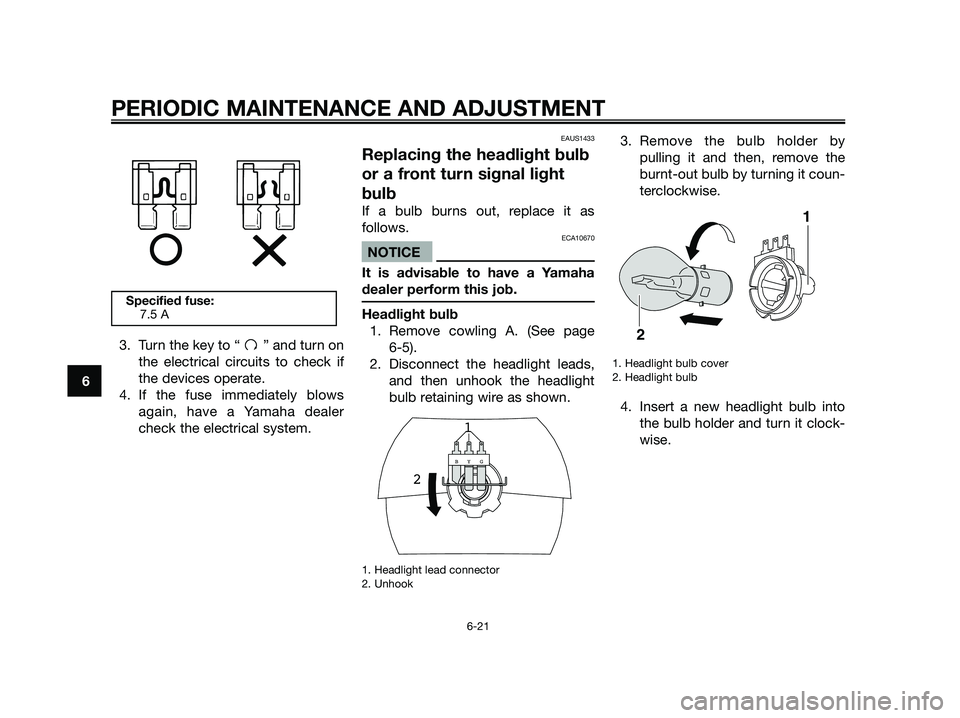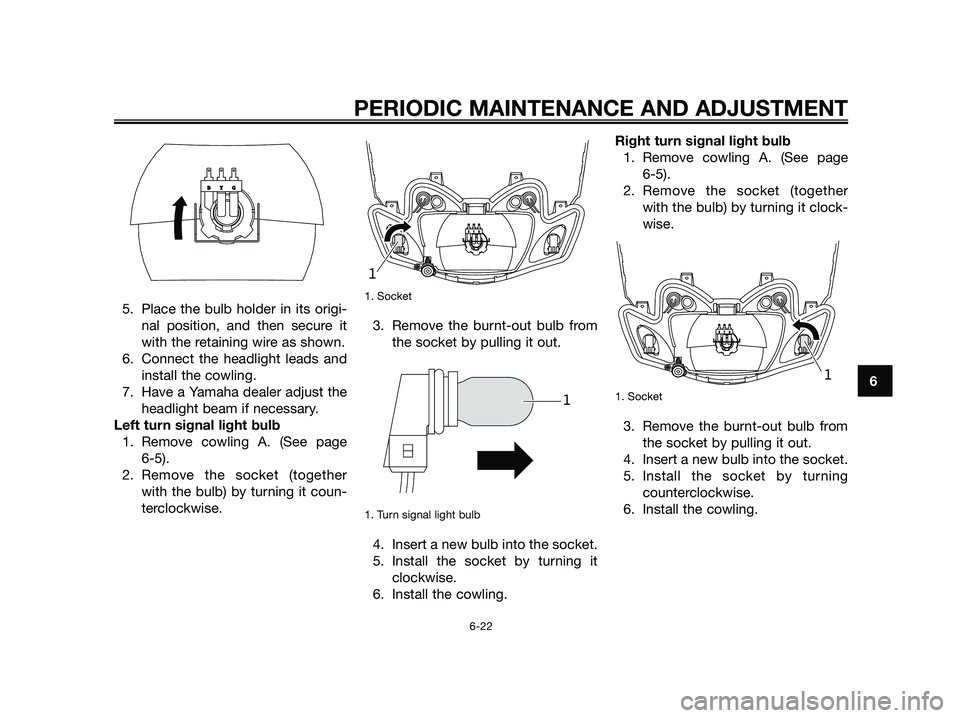light YAMAHA JOG50R 2014 User Guide
[x] Cancel search | Manufacturer: YAMAHA, Model Year: 2014, Model line: JOG50R, Model: YAMAHA JOG50R 2014Pages: 76, PDF Size: 1.51 MB
Page 36 of 76

EAU16793
BrakingEWA10300
sWARNING
●Avoid braking hard or suddenly
(especially when leaning over
to one side), otherwise the sco-
oter may skid or overturn.
●Railroad crossings, streetcar
rails, iron plates on road cons-
truction sites, and manhole
covers become extremely slip-
pery when wet. Therefore, slow
down when approaching such
areas and cross them with cau-
tion.
●Keep in mind that braking on a
wet road is much more difficult.
●Ride slowly down a hill, as bra-
king downhill can be very diffi-
cult.
1. Close the throttle completely.
2. Apply both front and rear brakes
simultaneously while gradually
increasing the pressure.Front
Rear
EAU16820
Tips for reducing fuel
consumption
Fuel consumption depends largely on
your riding style. Consider the follo-
wing tips to reduce fuel consumption:
●Avoid high engine speeds during
acceleration.
●Avoid high engine speeds with no
load on the engine.
●Turn the engine off instead of let-
ting it idle for an extended length
of time (e.g., in traffic jams, at
traffic lights or at railroad cros-
sings).
OPERATION AND IMPORTANT RIDING POINTS
5-3
5
Page 41 of 76

PERIODIC MAINTENANCE AND ADJUSTMENT
6-4
6
ODOMETER READING
CHECK OR ANNUAL
NO. ITEM MAINTENANCE JOB
1000 km 6000 km 12000 km 18000 km 24000 kmCHECK
(600 mi) (3500 mi) (7000 mi) (10500 mi) (14000 mi)
• Check coolant level and vehicle
19 *Cooling system
for coolant leakage.√√√ √√(CS50Z)
• Change. Every 3 years
20Final transmission • Check vehicle for oil leakage.
oil• Change.√√ √√ √ √
21 *V-belt• Replace. Every 10000 km (6000 mi)
22 *Front and rear
brake switches• Check operation.√√ √√ √ √
23Moving parts
and cables• Lubricate.√√√ √√
• Check operation and free play.
Throttle grip• Adjust the throttle cable free play
24 * if necessary.√√√ √√
housing and cable
• Lubricate the throttle grip
housing and cable.
25 *Lights, signals and • Check operation.
switches• Adjust headlight beam.√√ √√ √ √
EAUM2070
TIP
●The air filter needs more frequent service if you are riding in unusually wet or dusty areas.
●Hydraulic brake service
• Regularly check and, if necessary, correct the brake fluid level.
• Every two years change the brake fluid.
• Replace the brake hoses every four years and if cracked or damaged.
Page 42 of 76

EAU18740
Removing and installing the
cowling and panel
1. Cowling A
1. Panel A
The cowling and panel shown above
need to be removed to perform some
of the maintenance jobs described in
this chapter. Refer to this section
each time a cowling or panel needs to
be removed and installed.
EAUS1520
Cowling A
To remove the cowling
1. Remove the screws, and then
pull the cowling off as shown.
1. Cowling 2. Screw
2. Disconnect the headlight lead
connectors, the turn signal cou-
plers, and the auxiliary light cou-
plers.
1. Headlight lead connector 2. Auxiliary light coupler3. Turn signal coupler
To install the cowling
1. Connect the headlight leads con-
nectors, the turn signal couplers,
and the auxiliary light couplers.
2. Place the cowling in the original
position, and then install the
screws.
GGYYBB
1
2
3
21
1
1
PERIODIC MAINTENANCE AND ADJUSTMENT
6-5
6
Page 43 of 76

EAUM1250
Panel A
T
o remove the panel
1. Open the storage compartment.
(See page 3-11).
2. Remove the screw, and then take
the panel off.
1. Screw
2. Panel A
To install the panel
1. Place the panel in the original
position, and then install the
screw.
2. Close the storage compartment.
EAU19622
Checking the spark plug
The spark plug is an important engine
component, which should be chec-
ked periodically, preferably by a
Yamaha dealer. Since heat and depo-
sits will cause any spark plug to
slowly erode, it should be removed
and checked in accordance with the
periodic maintenance and lubrication
chart. In addition, the condition of the
spark plug can reveal the condition of
the engine.
The porcelain insulator around the
center electrode of the spark plug
should be a medium-to-light tan (the
ideal color when the vehicle is ridden
normally). If the spark plug shows a
distinctly different color, the engine
could be operating improperly. Do not
attempt to diagnose such problems
yourself. Instead, have a Yamaha
dealer check the vehicle.
If the spark plug shows signs of elec-
trode erosion and excessive carbon
or other deposits, it should be repla-
ced.Before installing a spark plug, the
spark plug gap should be measured
with a wire thickness gauge and, if
necessary, adjusted to specification.
1. Spark plug gap
Clean the surface of the spark plug
gasket and its mating surface, and
then wipe off any grime from the
spark plug threads.
Spark plug gap:
0.6–0.7 mm (0.024–0.028 in)
1
ZAUM0037
Specified spark plug:
NBR8HS/NGK (for CS50 CS50Z)
BPR4HS/NGK (for CS50M)
1
2
PERIODIC MAINTENANCE AND ADJUSTMENT
6-6
6
Page 45 of 76

6. Refill with the specified amount
of the recommended final trans-
mission oil, and then install and
tighten the oil filler cap. WAR-
NING! Make sure that no
foreign material enters the final
transmission case. Make sure
that no oil gets on the tire or
wheel.
[EWA11311]
7. Check the final transmission case
for oil leakage. If oil is leaking,
check for the cause.
EAUS1200
Coolant (CS50Z)
The coolant level should be checked
before each ride. In addition, the coo-
lant must be changed at the intervals
specified in the periodic maintenance
and lubrication chart.
EAUM2102
To check the coolant level
1. Place the vehicle on a level surfa-
ce and hold it in an upright posi-
tion.
TIP
●The coolant level must be chec-
ked on a cold engine since the
level varies with engine tempera-
ture.
●Make sure that the vehicle is
positioned straight up when
checking the coolant level. A
slight tilt to the side can result in
a false reading.
2. Check the coolant level through
the check window.
TIP
The coolant should be between the
minimum and maximum level marks.
1. Coolant level check window
2. Maximum level mark
3. Minimum level mark
3. If the coolant is at or below the
minimum level mark, remove the
cowling A. (See page 6-5).
4. Open the reservoir cap, and then
add coolant to the maximum
level mark. WARNING! Remove
only the coolant reservoir cap.
Never attempt to remove the
radiator cap when the engine is
hot.
[EWA15161]. NOTICE: If coolant
is not available, use distilled
MAX
MIN2
3
1
Recommended final transmission
oil:
See page 8-1
Oil quantity:
0.11 L (0.12 US qt, 0.10 Imp.qt)
Tightening torque:
Final transmission oil drain bolt:
18 Nm (1.8 m•kgf, 13.0 ft•lbf)
PERIODIC MAINTENANCE AND ADJUSTMENT
6-8
6
Page 58 of 76

3. Turn the key to “ ” and turn on
the electrical circuits to check if
the devices operate.
4. If the fuse immediately blows
again, have a Yamaha dealer
check the electrical system.
EAUS1433
Replacing the headlight bulb
or a front turn signal light
bulb
If a bulb burns out, replace it as
follows.
ECA10670
NOTICE
It is advisable to have a Yamaha
dealer perform this job.
Headlight bulb
1. Remove cowling A. (See page
6-5).
2. Disconnect the headlight leads,
and then unhook the headlight
bulb retaining wire as shown.
1. Headlight lead connector
2. Unhook
3. Remove the bulb holder by
pulling it and then, remove the
burnt-out bulb by turning it coun-
terclockwise.
1. Headlight bulb cover
2. Headlight bulb
4. Insert a new headlight bulb into
the bulb holder and turn it clock-
wise.
1
2
GYB
1
2
Specified fuse:
7.5 A
PERIODIC MAINTENANCE AND ADJUSTMENT
6-21
6
Page 59 of 76

5. Place the bulb holder in its origi-
nal position, and then secure it
with the retaining wire as shown.
6. Connect the headlight leads and
install the cowling.
7. Have a Yamaha dealer adjust the
headlight beam if necessary.
Left turn signal light bulb
1. Remove cowling A. (See page
6-5).
2. Remove the socket (together
with the bulb) by turning it coun-
terclockwise.1. Socket
3. Remove the burnt-out bulb from
the socket by pulling it out.
1. Turn signal light bulb
4. Insert a new bulb into the socket.
5. Install the socket by turning it
clockwise.
6. Install the cowling.Right turn signal light bulb
1. Remove cowling A. (See page
6-5).
2. Remove the socket (together
with the bulb) by turning it clock-
wise.
1. Socket
3. Remove the burnt-out bulb from
the socket by pulling it out.
4. Insert a new bulb into the socket.
5. Install the socket by turning
counterclockwise.
6. Install the cowling.
GGYYBB
1
1
GGYYBB
1
GGYYBB
PERIODIC MAINTENANCE AND ADJUSTMENT
6-22
6
Page 60 of 76

EAUT1923
Replacing the tail/brake light
bulb or a rear turn signal
light bulb
1. Tail/brake light lens
Tail/brake light bulb
1. Remove the tail/brake light lens
by removing the screws.
1. Screw
2. Tail/brake light lens
2. Remove the burnt out bulb by
pushing it in and turning it coun-
terclockwise.
1. Tail/brake light bulb
3. Insert a new bulb into the socket,
push it in, and then turn it clock-
wise until it stops.
4. Install the lens by installing the
screws.
Rear turn signal light bulb
1. Remove the tail/brake light lens
by removing the screws.
1. Screw
2. Turn signal light lens
2. Remove the turn signal light lens
by removing the screw.
1
2
1
1
2
1
PERIODIC MAINTENANCE AND ADJUSTMENT
6-23
6
Page 61 of 76

1. Turn signal light bulb
3. Remove the burnt out bulb by
pushing it in and turning it coun-
terclockwise.
4. Insert a new bulb into the socket,
push it in, and then turn it clock-
wise until it stops.
5. Install the turn signal light lens by
installing the screw.
6. Install the tail/brake light lens by
installing the screws. NOTICE:
Do not overtighten the screws,
otherwise the lens may break.
[ECA10681]
EAUS1151
Replacing the license plate
light bulb (Depends on
models)
1. Remove the lens by removing the
screw.
1. Screw 2. License plate light bulb socket
2. Remove the burnt out bulb by
pulling it out.
3. Insert a new bulb into the socket.
4. Install the lens by installing the
screw. NOTICE: Do not over-
tighten the screw, otherwise
the lens may break. [ECA11191]
EAUS1412
Replacing an auxiliary light
bulb
This model is equipped with two auxi-
liary lights. If an auxiliary light bulb
burns out, replace it as follows.
1. Remove cowling A. (See page
6-5).
2. Remove the auxiliary light socket
(together with the bulb) by pulling
it out.
1. Auxiliary light bulb socket
3. Remove the burnt-out bulb by
pulling it out.
GGYYBB
1
21
1
PERIODIC MAINTENANCE AND ADJUSTMENT
6-24
6
Page 62 of 76

1. Auxiliary light bulb
4. Insert a new bulb into the socket.
5. Install the auxiliary light socket
(together with the bulb) by pus-
hing it in.
6. Install the cowling.
EAU25881
Troubleshooting
Although Yamaha scooters receive a
thorough inspection before shipment
from the factory, trouble may occur
during operation. Any problem in the
fuel, compression, or ignition sys-
tems, for example, can cause poor
starting and loss of power.
The following troubleshooting charts
represent quick and easy procedures
for checking these vital systems your-
self. However, should your scooter
require any repair, take it to a Yamaha
dealer, whose skilled technicians
have the necessary tools, experience,
and know-how to service the scooter
properly.
Use only genuine Yamaha replace-
ment parts. Imitation parts may look
like Yamaha parts, but they are often
inferior, have a shorter service life and
can lead to expensive repair bills.
EWA15141
sWARNING
When checking the fuel system, do
not smoke, and make sure there
are no open flames or sparks in the
area, including pilot lights from
water heaters or furnaces. Gasoli-
ne or gasoline vapors can ignite or
explode, causing severe injury or
property damage.
1
PERIODIC MAINTENANCE AND ADJUSTMENT
6-25
6